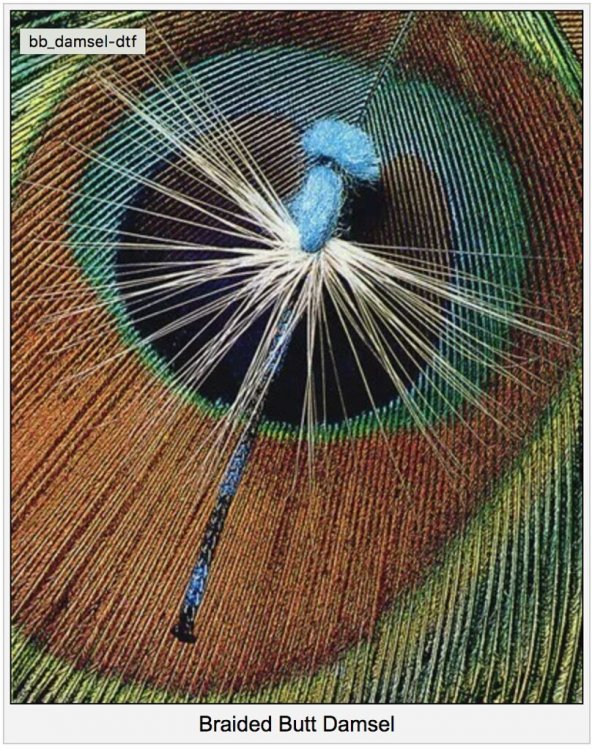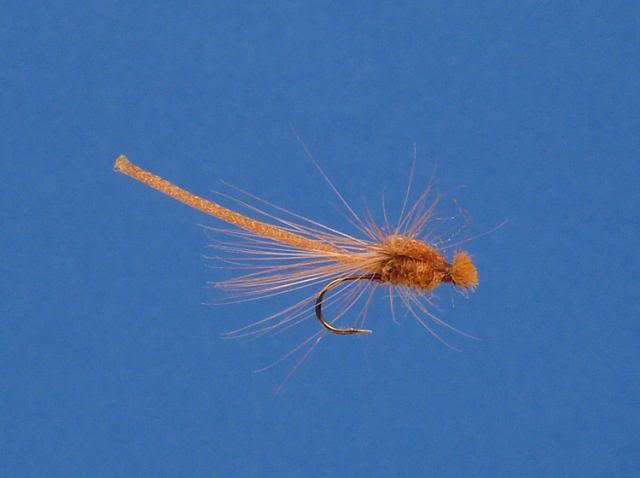-
Content Count
3,507 -
Joined
Posts posted by SilverCreek
-
-
43 minutes ago, niveker said:Years ago I used the formulas included with the Orvis leader kit. Just came across it again the other day, I don't imagine the line is good anymore. I think there's 27 spools of nylon line of different diameters.
Has it been stored away in a air tight container (protects against ozone) away from light in the dark?
If so, it is probably still OK. Test strength of thinner line.
-
6 hours ago, chugbug27 said:They are about the least clumsy of everything out there, huh? Maybe not the type of sinking you're thinking of, but... they do travel underwater to oviposit.... From Ralph and Lisa Cutter's Bugs of the Underworld...
The ovipositing damsel adult is a stage that cannot be imitated by almost all adult damsel patterns. Congratulations to Mark Knapp for tying some sinking adult damsels.
My favorite pattern is Gary Borger's adult damsel pattern, the Braided Butt Damsel. The patterns that have imitated Gary and used braided butt are like the one below
which uses foam. Obviously the pattern below will not sink.
The Borger pattern uses a yarn body which allows the fly to sink. Here is the pattern from the cover of Gary's book.
The Borger pattern also can be adapted to tie the immature teneral stage of the blue damsel.

Instructions for the Borger Braided Butt Damsel:
MATERIALS:
Hook: #10 Tiemco TMC100 or equivalent dry fly hook
Thread: Black Monocord
Abdomen: 30 Lb. Cortland braided mono dyed with permanent markers. Start with white braided mono and use a permanent marker (BCS 136) to dye it blue. Then use a black marker to give it alternating blue and black bands. I use a Berol Prismacolor Art Marker PM-40 Copenhagen Blue. Gary recommends a Process Blue Marker but I haven't been able to find it. Cut it into sections 3 .5 cm. long (about 1.25 inches) and melt one end of the mono with a cigarette lighter to seal it.
Post: Dazzelaire yarn - Island Blue color
Thorax: Dubbing made from the post yarn. I comb out the end of the yarn with a regular hair comb and cut the combed out yarn into 2-3 inch strips. Then I repeatedly comb all of this until it becomes one pile of dubbing.
Hackle: Light dun or Sandy dun cock hackle tied parachute style. Hackle should be about the length of the body.
TYING INSTRUCTIONS:
1. Bring the thread to the back of the hook and make a small ball of thread or a small dubbing ball on the hook. This should be placed so that it will elevate the abdominal segment off the hook. Take the unsealed end of the abdomen segment and fray the mono for 1/4 inch. Tie down the mono using the frayed end and put on some super glue and overwrap the mono back to the tread ball
2. Double up the yarn so that it forms a loop for the yarn post. Off set the ends slightly so that the transition on the hook will be smooth. Tie down the yarn ends in front of the abdominal segment on top of the superglue and wrap back so that the post starts just at the fur ball. Wrap the shaft of the post to form a base for the parachute hackle.
3. Place the hackle so that the concave (shiny) side faces down and tie down with two wraps. Put some dubbing on the thread and overwrap the body to hide the dark thread at the base of the post and the tie down area for the hackle. Take three to four wraps with the hackle, tie it down, and cut it off.
4. Dub the thread and wrap the thorax to the head of the fly. Spread the hackle in the front of the fly to the sides and pull the yarn post forward over the thorax and wrap it down behind the eye. Bring the thread in front of the yarn and whip finish the head. Cut the extra yarn post off leaving about a stub of yarn about as long as the eye of the hook. The black thread around the yarn simulates the eyes of the insect and the stub of yarn, the head.
5. Straighten out the hackle in a smooth semicircle in back of the thorax and arrange the abdomen in an upward curve. Put *clear* and *thinned* head cement at the base of the thorax and hackles to hold them in place. Put some head cement between the abdomen segment and the dubbing ball to hold the abdomen in position.
6. Tying hints - Dye and band the abdominal segments as one long piece of braided mono, then cut to length and melt the end. Put on the head cement after you finish all the flies. Do not skip the superglue or your abdominal segments may pull out. Use a whip finish on the head and you can skip the head cement for this area.
-
There is some excellent advice in the posts above.
Here is what I have to say.
1. Everyone that is an expert was once a beginner, even Charlie Craven.
2. The internet is a wonderful thing BUT internet cannot duplicate what is found in a good fly tying book. The fly tying book is organized in logical steps to teach fly tying by teaching you skills in a logical fashion and steps to tie basic and then more complex flies that you can actually fish. I used Fling and Putterbaugh. You can buy one used here:
https://www.amazon.com/Basic-Manual-Fly-Tying-Paul-Fling/dp/0806981466
3. Piss poor materials material make learning fly tying more difficult and create piss poor flies. Do not waste money in all in one kits UNLESS the kit is sold by ORVIS. They sell beginner kits with decent tools and material. However, I still prefer buy a higher quality flies and tools if you are sure you will continue to tie.
4. Personal instruction beats watching videos. I learn from the best - Gary Borger - and he gave me a huge advantage right at the start.
5. Even experts use tools rather than doing things "the traditional way." For example, Charlie Craven uses a Materreli style whip finisher - it is the best and much faster than whip finishing by hand. A 5 turn whip finish requires no head cement to prevent the fly from unravelling.
https://www.jsflyfishing.com/products/materelli-style-rotary-whip-finisher?variant=43244984893669
https://youtu.be/_3oGi7eU7Qg?si=0MHa_a33cwS7Rzph
6. Ihe Benchside Reference is the Bible of fly tying and I own one of the original copies of the 1998 edition, but in my opinion it is no a book for a beginner. I suggest you buy a used Fling and Putterbaugh's Basic Manual of Fly Tying.
-
To whoever manages the forum.
All the menu options seem to be working so 🤙 to those who repaired the forum!!!!
-
13 hours ago, tagsoup said:chugbug27, thanks for the detailed response. I wondered if there were other materials besides hackle that might present a quality vs quantity dilemma but I never would've guessed deer hair or turkey tail feathers as common as those are. Luckily, since archery deer season has come and gone for me I won't be scrutinizing my quarry for the fly tying potential of its hide. The Elk Hair Caddis is one of the flies I want to tie so I'll probably ask hair related questions soon, and I'll hold off on attempting Dave's Hopper until I pass Deer and Elk hair 101.
Thank you for pointing me to wholesaleflycompany.com for hooks! I groaned when I saw the price of Daiichi hooks but dropped $80 on them in my first order anyway. My wooly buggers really will cost three times as much as Umpqua buggers, but I guarantee the maribou won't just fall off.
Read this for finding the right hair for the EHC.
For inexpensive hooks try The Fly Shack.
-
Take care of yourself and I hope you get better.
-
17 minutes ago, chugbug27 said:I'm no expert, but I don't think my dubbing being twisted one way or another will effect the thread twist... Usually my bobbin is in hand, so the thread twist isn't going anywhere. But, if you twist it one way, the dubbing will loosen as you wrap, and if you twist it the other it will tighten as you wrap. For a right hander using your right hand to dub, moving your thumb to finger tip to apply dubbing to the thread (or twisting your dubbing loop tool that way) will give you tight dubbing; and moving your thumb from fingertip down will loosen your dubbing as you wrap the dubbing noodle around the hook.
I am assuming that a right handed tier wraps the thread by going up over and the hook. Pull the tying thread towards you and look down the length of the thread to the hook. With the thread in that position:
If you dub counter clockwise, the dubbing will get tighter as you wind the dubbing on the hook.
If you dub clockwise, the dubbing will get looser as you wind the dubbing on the hook.
For you beginners, try dubbing both ways to see what I mean.
-
On 8/20/2023 at 10:06 PM, Gene L said:How strictly do you follow the traditional pattern? If you tie, say, an Adams, you strictly follow the pattern in the pattern book? Or are you allowed to make substitutions? And if you do, is it no longer an Adams? I'm happy to get the basic components so I substitute and do so in a carefree manner. As a result, it ain't pretty. It may not even be an Adams.
An Adams is a specific pattern tied with specific materials.
There are variants like a Parachute Adams or a Grizzly Adams but they are not the original Adams.
In fact, the original pattern may no longer be the most popular. In the case of the Adams Dry Fly, the Parachute Adams is much more popular and is the most popular dry fly sold in the USA and in the world.
https://www.panfishonthefly.com/blog/2018/4/18/the-most-popular-dry-fly-in-the-world
-
I enjoyed the report and pictures.
Thanks for posting.
-
I use regular head cement or Sally Hansen's Hard as Nails.
It's been awhile since I filled it. I fill it up to about 1/2. I use Beauty Secrets Nail Polish Thinner to thin the Sally Hansen's when needed.
Read this thread:
https://www.theflyfishingforum.com/forums/index.php?threads/thickened-head-cement.368253/#post806870
-
I use a Renzetti applicator jar with needle applicator. The jar seal sits on the bottle top so keep the head cement form evaporating while you are tying.

-
I think heat is used for epoxy but make sure before trying it.
-
Your resting pulse pressure is systolic - diastolic = 146-80 = 66. Normal pulse pressure is about 40 so your pulse pressure is high.
https://www.healthline.com/health/pulse-pressure
I am not a cardiologist but I suggest asking your MD whether the elevated pulse pressure is a concern for your age.
-
Since your friend built the rod, ask him what kind of glue he used to attach the grip to the rod and how to remove the grip.
-
I don't often say never, but in the last 20 years, I have never bought hackle or deer/elk hair or patches of fur for dubbing without being able to examine what I was buying for color and quality.
Having the "right" materials makes tying a lot easier and the flies a lot truer to the pattern.
-
1 hour ago, flytire said:My family and spent 2 spent 2 weeks every summer for about 15 years in Yellowstone Park. We've seen tourist do stupid things including walking up to the Old Faithful Geyser. But not as bad as the events below.
-
I bought a Rolex Seamaster when I was returning from Germany in 1966. It lasted for many, many years and then died. I now wear an inexpensive Timex.
-
Sorry to hear about your loss.
I've had several dogs and they are family.
-
Fortunately, all our lines are underground so ice storms do not seem to have much effect on us.
-
I've thought about a backup system but it requires periodic maintenance. In the 22 years that I have been in my current home, the power longest the power has been off is about 3 hours. Most of the time, it is just a few seconds or rarely a few minutes. Now I am glad I didn't spend the money for a backup system. BUt then again, the electrical grid and infrastructure is very stable and well maintained in Wisconsin.
Now I've gone and jinxed myself and I'll probably loose power for several days tonight...... :^((
-
Gary Borger bends the hook of his poly caddis so that the wing is flat over the back of the fly. He also cuts off the bottom of the hackle so the fly body lies flat on the water surface.
-
On the Challenge Thread, I commented on Nelson's Caddis. I wanted to post about one of my favorite caddis patterns and did not want to get that thread to deviate from the subject which was Nelson's Caddis.
One of the best imitative caddis patterns that I have tied and used is a modified version of Eric Leiser's Woodchuck Caddis. Below is the pattern taken from the Pike - Wayne Chapter of TU.

The way I tie the pattern is just like the elk hair caddis but substitute woodchuck hair for the elk hair. Elk hair is hollow and so when it is compressed and tied in, the hair flairs and wing of the pattern is elevated above the body.
Woodchuck hair is solid and does not flair so it lies relatively flat over the body of the fly.
Whereas the EHC pattern looks like a fluttering caddis, the woodchuck caddis pattern looks like a caddis with the wings folded over it's body.
You might be surprised that the most popular caddis dry fly pattern, the elk hair caddis in not in Gary Lafountaine's book Caddisflies. The reason is that it is not a very good imitation of a caddis resting on the water. It is an imitation of a fluttering caddis. The EHC works in the riffles where the fish do not get a good look at the fly but when the trout are BOTH selective and the water is calm and clear, the EHC is not a very effective pattern.
This is when to use a woodchuck caddis WITHOUT the palmered hackle.
I tied some up for a friend. He was fishing a caddis hatch on a spring creek in the driftless area of southern Wisconsin. There was a caddis hatch and he put on a EHC which the trout ignored. After getting frustrated by refusal after refusal, he remembered the woodchuck caddis I had given him and it saved his outing.
So tie up a few of these for your fly box. It may save your day.
-
1 hour ago, cphubert said:Nelson's Caddis (Nelson Ishiyama)
I found two patterns for the fly. First was a simple wing, second pattern and I think the original pattern with 2 bunches of hair for the wing. The antenna is optional but noted on the second pattern. I believe this pattern was originated in Henry's Fork but not 100% sure. I like the second pattern and need to tie it in a few other colors.
Hook- Mustad 94840, thread- brown, tail- deer hair tied short, body- olive brown dubbing, wing- deer hair (1st single bunch, second two bunches), hackle-dark ginger, antenna-moose mane.
Apologize for the delay I suffered a migraine yesterday and did nothing all day a little fuzzy still today must be the humidity.
Next fly up Smokey Mountain Blackbird
Thank you for tying that fly. It brings back a lot of very fond memories for me from 48 years ago when I first met Nelson.
Nelson Ishiyama, the originator of Nelson's Caddis, is a fraternity brother of mine and a personal friend.
We both attended Stanford University. I stayed for Stanford medical school and Nelson stayed and got a Stanford law degree and then a Stanford MBA. So we have known each other a very long time.
Nelson was a personal friend of Mel and Fanny Krieger and he edited Mel's book, The Essence of Fly Casting.
Among his many businesses, Nelson owns the Henry's Fork Lodge and can be found fishing "The Fork" with his bamboo fly rod.
-










Tippet -- The good, bad & ugly...
in Fly Fishing Gear & Techniques
Posted · Report reply
Then I would toss it.
With tippet that old, if the tippet was still good, modern tippets are so much stronger per diameter and limper that the old tippet would be less effective.